![]() If you’re studying the last 100 million years or so of plate tectonics, the history of sea-floor spreading recorded by the magnetic stripes that parallel and extend away from the Earth’s ocean ridges is a key source of information. Each stripe represents a section of oceanic crust that is magnetised either in the same direction as the Earth’s magnetic field generated in the outer core, or in the opposite direction. These crustal magnetisations act to slightly reinforce or slightly cancel out the core field, respectively, and are the result of continuous production of oceanic crust at the mid-ocean ridges, combined with the periodic reversals of the Earth’s magnetic field
If you’re studying the last 100 million years or so of plate tectonics, the history of sea-floor spreading recorded by the magnetic stripes that parallel and extend away from the Earth’s ocean ridges is a key source of information. Each stripe represents a section of oceanic crust that is magnetised either in the same direction as the Earth’s magnetic field generated in the outer core, or in the opposite direction. These crustal magnetisations act to slightly reinforce or slightly cancel out the core field, respectively, and are the result of continuous production of oceanic crust at the mid-ocean ridges, combined with the periodic reversals of the Earth’s magnetic field
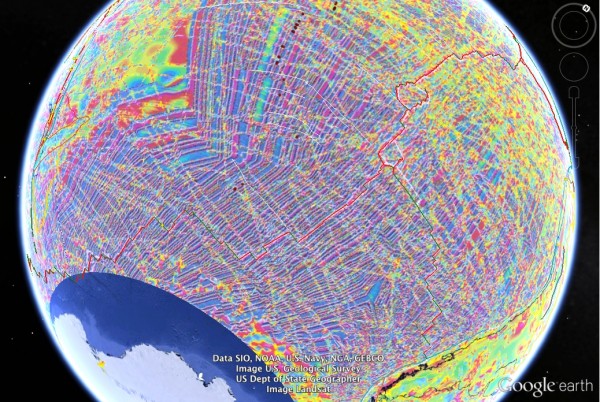
Magnetic anomalies in the South Pacific: part of the World Magnetic Anomaly Map, via a Useful KML file from San Diego State University
Key to using these anomalies to reconstruct plate motions are the boundaries between positively and negatively magnetised stripes of crust. These boundaries represent oceanic crust that was produced at the spreading ridge at the time when the Earth’s magnetic field reversed. A boundary marking each reversal can be found on both plates at a spreading ridge, representing crust that must have been in contact at the ridge axis during the time of the reversal, before being separated by continued oceanic spreading between the two plates. Just find the rotation that causes these two lines of equal time, called isochrons, to overlap with each other, and you have a well-determined record of how fast, and in what direction, the plates have moved apart from each other since the time of that magnetic reversal. Nice and easy.
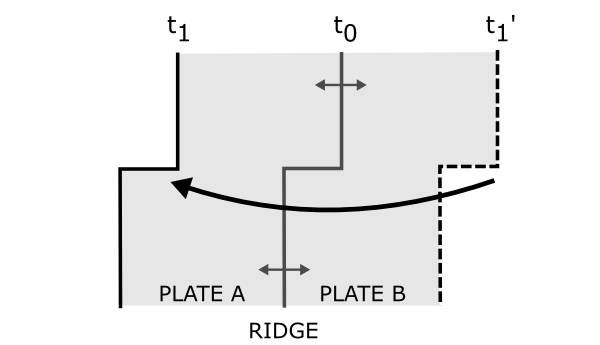
If you can identify the same magnetic anomaly boundary (t1) on both sides of an active spreading ridge, you can reconstruct the spreading since that reversal by finding the rotation that puts the paired anomalies back on top of each other.
These data are not just important for describing the behaviour of individual ridge systems, but also for understanding plate tectonic processes on a global scale. The 60,000 km of oceanic spreading ridge that wind their way through the modern ocean basins, 4 kilometres beneath the ocean surface, are a major conduit of heat and mass transfer between the interior of the Earth and its surface. There is some debate over whether the rate of oceanic crust production has varied over geological time; this could potentially effect the global climate, by increasing or decreasing the flux of carbon dioxide into the oceans and atmosphere. Faster spreading rates would also mean a larger proportion of young, hot, buoyant oceanic crust flooring the ocean basins, making them shallower and raising global sea levels – conversely, a reduced global spreading rate would lower them.
It turns out that for the global spreading rate picture, reconstructing the history of what is now the East Pacific Rise is a very important part of the puzzle. The modern East Pacific Rise is the fastest spreading ridge on Earth, accommodating the rifting of the Pacific and Nazca plates at rates of up to 15 centimetres a year (compared to a global average of about 4.5 centimetres a year).
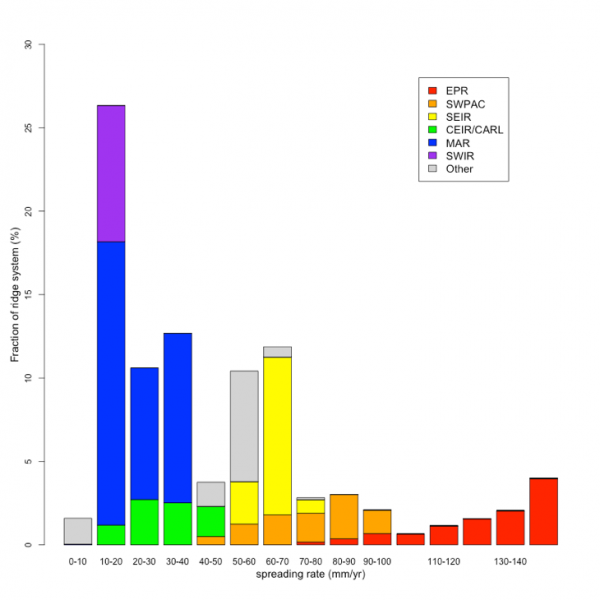
A graph showing the distribution of spreading rates on the different oceanic ridges. The EPR, in red, has much faster spreading rates than any other ridge.
It has also had a very interesting tectonic history. The modern East Pacific Rise is mostly restricted to the Southern hemisphere, running into North America in the Gulf of California; but 80 million years ago, it was part of a much longer ridge system, almost 10,000 km long, that extended much further north. At this point, the plate on the eastern side of the ridge was known as the Farallon Plate.

A global plate reconstruction at 80 million years before the present, showing a much longer Pacific-Farallon Ridge in the Western Pacific. Source: Seton et. al. (2012).
Just like today, the Pacific ocean 80 million years ago was ringed by subduction zones, and it turned out that the northern part of the Pacific-Farallon ridge was living on borrowed time; the rate at which old Farallon plate was being returned to the mantle by subduction beneath the west coast of North America was greater than the rate at which new Farallon crust was being added at the ridge. And thus the ridge itself gradually approached, and then collided with, North America, and the once-mighty Farallon Plate broke up into a number of smaller fragments. The animation below, courtesy of Tanya Atwater shows this process.
http://youtu.be/G2_1dqgai10
There are two significant points here. Firstly, for most of the last 100 million years or so, the spreading ridge in the Pacific ocean has been very long, or very fast spreading, or potentially both. In fact, our best estimates suggest that this single ridge system is responsible for about 40-45% of all of the oceanic crust produced since about 83 million years ago. Thus a change in spreading on this ridge at some point in the geological past could potentially have significant global effects. But secondly, accurately reconstructing the spreading history is made significantly more difficult by the almost total destruction of the Farallon plate by subduction; it is hard to find the rotation between matching isochrons when once of those isochrons is now somewhere in the mantle beneath Iowa.
So what to do? One approach, which is the basis of a paper I’ve just had published in Geophysical Journal International, is to make the best of what is left: the record of spreading still retained on the unsubducted Pacific plate. We can’t rotate matching anomaly boundaries on the two different plates back together to find the total spreading, but we can rotate adjacent anomaly boundaries on the same plate (the Pacific Plate, in this case) back together to find how much spreading occurred on the western side of the ridge between the two reversals, which should be mirrored by spreading on the (now-destroyed) eastern side of the ridge in the same time period.
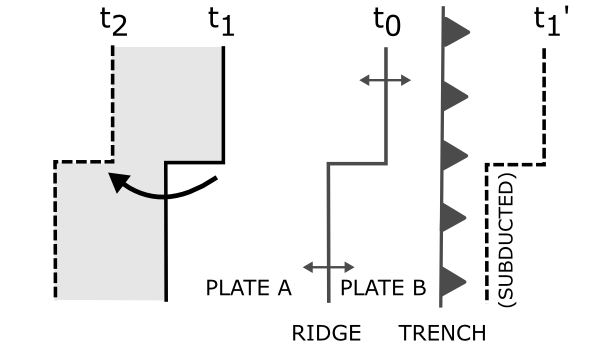
If one plate has been subducted, you don’t have pairs of magnetic anomaly boundaries that formed at the same time. But you can reconstruct rotations between anomaly boundaries on the same plate, and use that to extrapolate how much crust was produced in the same time period on the now-subducted plate.
It’s not ideal, because the shape of the ridge can and does change over time, so that adjacent anomaly boundaries are not an exact geometric match to each other. There’s also the fact that the East Pacific Rise is an asymmetric spreading ridge: based on the increasingly limited record in the South Pacific, only about 42% of all the oceanic crust produced in the past 50 million years has been added on the west (Pacific) side of the ridge, with the remaining 58% being added to the eastern (Farallon/Nazca) side. Our new paper attempts to better quantify how this spreading asymmetry varies over time where we do have a record, to set limits on what may have happened prior to 50 million years ago, when we have no record at all.
So what have we determined? The plot below shows how the average spreading rate of the Pacific-Farallon ridge has changed over time. It has never been exactly slow, but there seems to have been a transition from ‘pretty darn fast’ to ‘extremely darn fast’ around 50 million years ago.
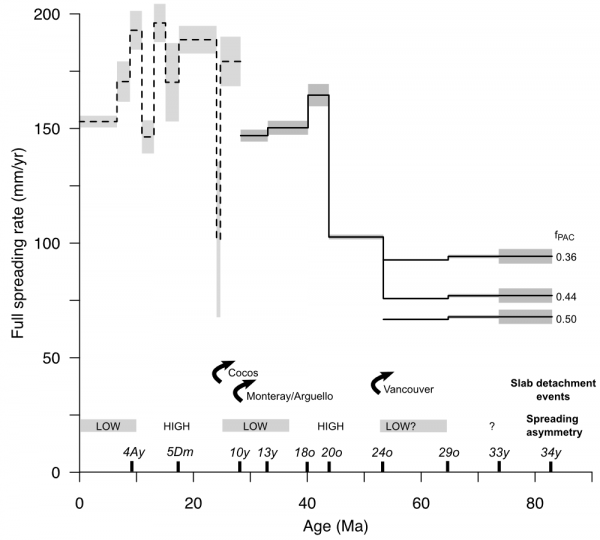
Reconstructed spreading rate of the Pacific-Farallon ridge as it progressively collided with North America and shortened to form the modern East Pacific Rise. Also shown: major fragmentation events on the Farallon plate, and the broad variation in spreading asymmetry. From Rowan and Rowley (2014).
This increase coincides with the first stages of Farallon plate break-up, but although the timing is right, in some ways the response is the opposite of what you’d expect. Surface plate motions are largely thought to be driven by the pull of dense subducting slabs as they sink into the mantle; if this is the case, reducing the amount of subducting slab attached to your plate by breaking a bit off should also reduce the driving forces and slow the remaining plate down, not accelerate it. Additionally perplexing is the fact that the direction of spreading does not really change at all during this transition, either, and is in fact remarkably stable through the entire period that the ridge is colliding with North America, when you would expect there to be large changes in the balance of slab pull forces.
So what is driving this change? We’re still working on that bit (my AGU talk last December was on this very subject), but currently the speculative finger is pointing at something acting at the ridge axis itself. The potential clue? As is also shown in the plot above, there are indications that periods of higher spreading rate over the past 50 million years coincide with periods of higher spreading asymmetry. If this correlation is real, only forces acting at the ridge axis can easily explain it. As is always the case in science, you answer one question, and several more pop up to replace it.
Rowan, C.J., and Rowley, D.B. (2014). Spreading behaviour of the Pacific-Farallon ridge system since 83 Ma. Geophys. J. Int., http://dx.doi.org/10.1093/gji/ggu056.



Comments (6)